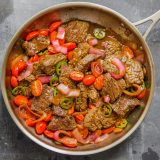Peru's lomo saltado is fusion cooking at its easiest and most approachable, a quick stir-fry of soy-marinated beef, tomatoes and hot peppers that reflects the country's cultural—and culinary—influences, from Incan farmers to Chinese immigrants.
Ancient settlers in the foothills of the Andes Mountains cultivated corn, quinoa, chili peppers and potatoes—3,000 types of which are native to Peru. Spanish colonizers introduced beef and sheep, supplanting local proteins like alpaca and guinea pig. Centuries later, in 1854, the abolition of slavery marked an influx of indentured Chinese workers, introducing ingredients like soy sauce and ginger, as well as their trademark stir-fry technique.
Chinese-Peruvian cuisine became known as chifa (derived from either the Mandarin “chifan,” meaning to eat rice, or the Cantonese “chifuan,” to cook). Today, Lima alone boasts thousands of chifa restaurants. Its flourishing Chinatown centers on Calle Cajón, a pedestrian street with Zodiac signs embedded in the red brick pavement. There and elsewhere in Peru, lomo saltado has become representative of the country's culinary diversity, which also includes hints of Italian and other European influences. The dish is standard on chifa menus—appearing alongside dishes such as arroz chaufa, a Cantonese-style fried rice, and gallina tipa kay, a sweet and sour chicken—but it's also often prepared at home.
Lomo refers to tenderloin, but various cuts of beef are used. The meat is always sliced into strips, marinated in soy sauce and wok-fried over high heat, along with fruity, orange-hued ají chilies (which turn yellow as they're cooked) and fresh tomatoes. A double dose of starch often rounds out the dish; it comes with potato wedges mixed in or french fries on the side, plus a scoop of rice to sop up the juices.
At Milk Street, we focused on the meat. To develop flavor, we mixed ground cumin into the soy sauce marinade. We used strip steak and opted to sear rather than stir-fry. Carefully patting the marinated meat dry to remove moisture prevented the meat from steaming.
Once the beef was browned, we set it aside and sautéed onions in the pan, then deglazed it with more soy sauce and red wine vinegar to pick up some meaty flavor and create a rich sauce. Garlic and jalapeños—a fine substitute for ají chilies—added aromatics and heat. Barely cooked grape tomatoes and a cilantro garnish helped keep the dish fresh, hearty without being heavy.




